Iodine for wound healing is one of the most proven methods. An alcohol solution of iodine should be in any home first aid kit for emergencies. It has a pronounced antibacterial effect, dries the skin and relieves inflammation. However, it is worth remembering that an excess of this element can have a detrimental effect on health, and in some cases it is contraindicated.
Benefits of the drug and methods of use
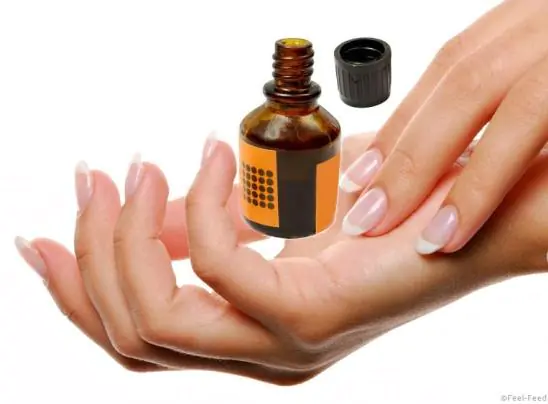
Iodine is an excellent first aid remedy for abrasions and scrapes. It is effective if applied immediately after damage. This remedy has several effects:
- destroys pathogenic bacteria;
- prevents suppuration;
- relieves inflammation and promotes rapid healing of skin damage.
To treat a wound with iodine solution, you will need a bottle of medicine, a cotton swab and a bandage folded several times. If you don’t have cotton swabs on hand, you can form a tampon from a small piece of cotton wool or gauze bandage.
Minor abrasion or cut to finger
Fresh cuts and abrasions, if they are not accompanied by heavy bleeding, are recommended to be immediately treated with iodine. To do this, just apply a small amount of it to the scratch. The procedure may be accompanied by a burning sensation, but it goes away after a few minutes. It is recommended to apply a bandage to the wound surface, first placing a piece of cotton wool or a cotton pad under it.
To reduce the concentration of the active substance, you can prepare an alcohol or aqueous solution. This reduces the likelihood of getting a chemical burn, even on sensitive skin.
Open bleeding wound
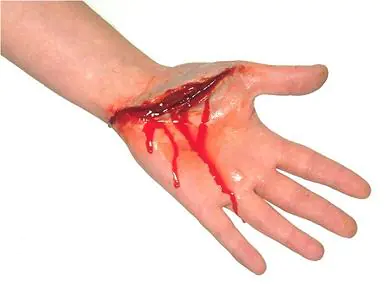
The basic rule for using the drug is that it is not suitable for treating open wounds.
It can be gently applied around the damaged area. The active substances are well absorbed into the skin and penetrate the bloodstream. This way you can avoid bacteria getting inside the wound and developing purulent complications.
Chlorhexidine or other antiseptic solutions are suitable for the inner surface of the wound. Applying iodine directly to open wounds is not recommended - its concentrate can cause a chemical burn, which will take longer to heal.
Cuts on hairy surfaces
Iodine can also be used to treat small cuts on the scalp. To do this, take a cotton swab and apply a small amount of concentrate directly to the abrasion.
The drug is contraindicated for wounds with a large wound surface and heavy bleeding.
You can shave the hair around the damage and apply it at a distance of 2-3 cm.
The speed of wound healing depends on their type, size, and the presence of complications.
Small scratches and shallow incised injuries heal in 4-7 days (provided that they have not become suppurated). Bite, laceration, and crush wounds will take longer to heal
Contraindications for use
Iodine is not only an antibacterial substance. It is involved in some processes in the body and is part of the thyroid hormones. Its excess can disrupt the functioning of the organ and the natural secretion of these substances.
The product has several contraindications for use:
- allergic reactions to iodine;
- thyroid diseases;
- children under 3 years of age;
- period of pregnancy and breastfeeding.
To treat burns and purulent wounds, you can use iodine-based ointment. This group includes drugs such as Povidone-iodine, Yodiskin, Yodokar and others. They contain the main active ingredient in the form of chemical compounds that also have pronounced antimicrobial activity.
How to wash off any remaining product
There are several ways to wash iodine from the skin after a wound has healed. It cannot be scrubbed off with ordinary soap and water because it reliably stains the skin a yellow-brown color. You can try one of the methods:
- apply a rich cream or natural oil to the skin so that the drug is absorbed faster and the stain disappears;
- take a bath with the addition of sea salt - the skin will soften, and it will be easier to remove the substance from it.
Iodine is one of the very first antiseptics that continues to be used at home. It destroys bacteria, relieves inflammation and dries wounds. This drug has several contraindications, so it should be used with caution. Ointment with iodine contains a similar substance in a lower concentration, which significantly reduces the risks of its use.
Povidone-iodine. Differences from regular iodine. Why is it better and more convenient?
Even a minor injury can cause serious health problems. Open wounds are especially dangerous. Bacteria and viruses can enter the affected area. A purulent infection often leads to blood poisoning, and this is a serious threat to life. Therefore, even the smallest wound must be properly treated with an antiseptic.
How to properly treat a wound?
Pharmacies have a huge number of antiseptic drugs that have antimicrobial and antiviral effects. But before using any medication, you must carefully study the instructions. The same alcohol, if used incorrectly, can cause a burn. It is better to entrust the treatment of wounds to a specialist. What to do if there is no way to go to the emergency room? There are a few rules to remember.
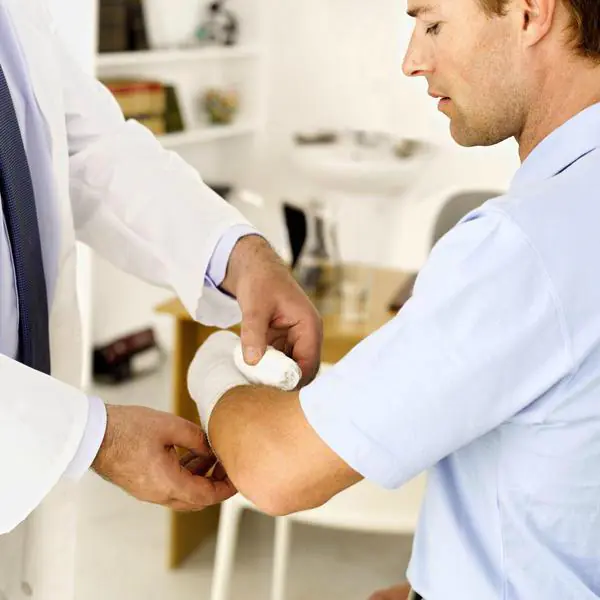
You should carefully choose an antiseptic for treating wounds in the eye and mouth area. The skin here is very delicate. Alcohol-based products may cause burns. It is recommended to treat the injured area with a weak aqueous solution.
Hydrogen peroxide
This is the most popular antiseptic for wound treatment. For minor injuries, use a 3% solution. Hydrogen peroxide at 6 percent concentration can cause serious skin burns. This substance is used only for storing and sterilizing medical instruments. Treatment of wounds with peroxide is accompanied by the formation of foam. This removes dirt and dead skin cells. The 3% solution is excellent for both washing superficial wounds and disinfecting mucous membranes.
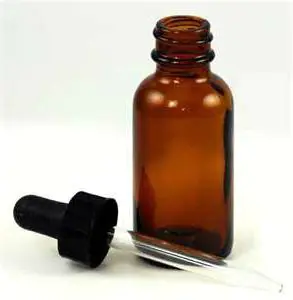
Hydrogen peroxide should not be used to treat already healing abrasions and other skin damage. Reviews show that wounds heal much longer if this antiseptic is used. The fact is that peroxide has a negative effect on young rumen cells. But for the initial treatment of a wound, this product is ideal.
Aqueous solution of the drug "Furacilin"
The antiseptic is not sold in ready-made form in pharmacies. It is available only by prescription. An alcohol solution can be obtained without problems, but it can only be used to treat purulent ear diseases. An aqueous solution of Furacilin can be prepared at home yourself. To do this, take 10 tablets of the drug and dissolve it in one liter of warm boiled water. The medicine can be used in the form of a spray. If you take much less liquid, you will get an antiseptic paste.
An aqueous solution of the drug "Furacilin" is a mild agent. According to reviews, this antiseptic is ideal for treating mucous membranes. It can also be used to treat wounds on delicate baby skin. The drug "Furacilin" is also used for skin suppuration. The product helps quickly remove the infection and promotes healing. Antiseptic paste can be used for dressing postoperative sutures. 10 tablets of "Furacilin" in pharmacies cost about 35 rubles.
Ethanol
A one-component alcohol-containing antiseptic is most often used to treat wounds and postoperative sutures. Optimal antimicrobial activity is provided by medical alcohol of 70% concentration. This substance is quite aggressive. Alcohol-based wound antiseptics are not acceptable when treating mucous membranes. It is worth remembering that this substance is quickly absorbed into the blood. Therefore, such drugs are also not recommended for use in children.
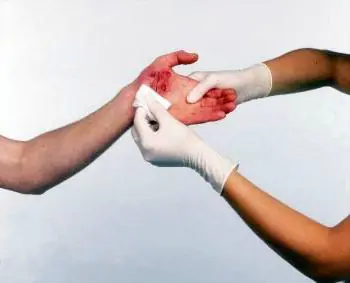
Chlorhexidine bigluconate
This drug, produced in the form of a solution, has a fairly wide spectrum of action. This antiseptic for wound treatment affects not only viruses and bacteria, but also copes with some types of fungal infections. The drug can be used for the initial treatment of injured areas, as well as to accelerate the healing of purulent wounds. A small amount of chlorhexidine will be enough to kill pathogens on the affected area of the skin.
In pharmacies you can find various drugs, the main component of which is chlorhexidine. Antiseptic gel can be used to heal wounds on the mucous membrane. You can also find medicines in the form of tablets and suppositories. According to patient reviews, such drugs are ideal for healing vaginal wounds. The cost of Chrolhexidine suppositories in pharmacies ranges from 150 to 200 rubles.
The drug "Miramistin"
The drug has high activity in the fight against many pathogenic microorganisms. In pharmacies you can find the drug in the form of an aqueous solution or ointment. The doctor will tell you which antiseptic is best suited in a particular case. To treat deep purulent wounds, ointment is most often used. It is applied to the affected area once a day. The wound is pre-treated with hydrogen peroxide or alcohol.
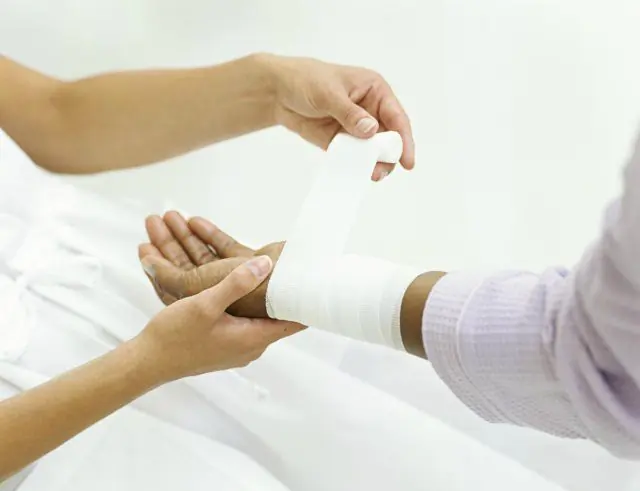
Miramistin is non-toxic. It can be used during pregnancy and lactation. The medication can be prescribed to treat deep wounds in children. Many parents note that the drug speeds up the recovery process of injured areas. In addition, children do not complain of pain or burning during treatment. The cost of this antiseptic in pharmacies is about 250 rubles.
Potassium permanganate solution
Potassium permanganate has pronounced antiseptic properties. Just 20 years ago, powdered potassium permanganate could be obtained without any problems. The solution was prepared quite simply. Just a few crystals of powder were enough to prepare a liter of antiseptic. But such a remedy had beneficial properties only for the first few hours.

This is a universal antiseptic that has antimicrobial, antiviral, and anti-inflammatory effects. An alcohol solution of iodine is used to treat wounds, as well as purulent rashes. Postoperative sutures can also be treated with this antiseptic.
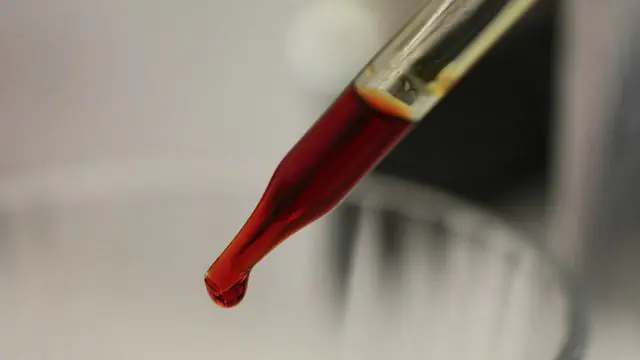
Povidone-iodine product
An iodine-based drug that has a less toxic effect on tissue. It is known that an alcohol solution of iodine is incompatible with other antiseptics. In addition, it may have a negative effect on the thyroid gland. The drug "Povidone-iodine" has a milder effect. Children can also use this wound antiseptic. The spray is used both to treat small injured areas and to treat purulent skin diseases. Deep wounds are treated only along the edges.
Brilliant green solution
Without this antiseptic it is impossible to imagine a single home first aid kit. Previously, this remedy was used from birth. It was brilliant green that was used to treat the umbilical wound. Today, other, more modern antiseptic drugs have appeared. But the solution of brilliant green has not lost its relevance. First of all, many are pleased with the price. You can buy a bottle of brilliant green in pharmacies for only 8-10 rubles. The product is also offered in a more convenient form - in the form of a marker. Zelenka can be easily applied to the affected area without getting dirty.
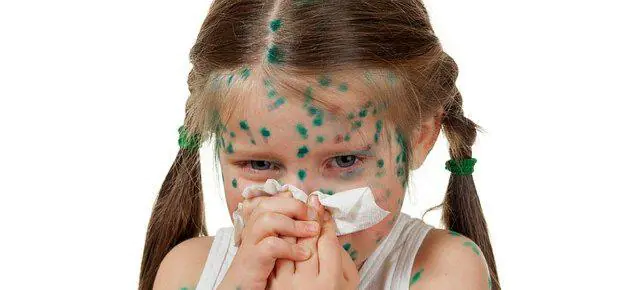
Medicine "Fukortsin"
Antiseptic for external use, the main components of which are boric acid and acetone. In pharmacies, the medicine "Fukortsin" is offered in dosages of 10, 25, and 50 ml. The cost of the smallest bottle does not exceed 10 rubles. The medication has many positive reviews. Patients note that the antiseptic promotes rapid scarring of wounds and has an antimicrobial and anti-inflammatory effect.
When applying the Fukortsin medication to the wound, you may feel pain and burning. The unpleasant sensations disappear within a few minutes. It is not recommended to apply the antiseptic to large areas of skin. The drug is absorbed into the blood. An overdose may cause dizziness and weakness.
An antiseptic is applied to the affected area of skin several times a day. After the product has dried, compresses, ointments and pastes can be applied to the wound. As soon as scarring of the damaged tissue begins, the use of the drug "Fukortsin" is stopped.
The drug can also be used as part of complex therapy in the treatment of fungal skin diseases. The antifungal effect is provided due to the phenol included in the drug. Inflamed areas are wiped with a cotton swab dipped in the solution. The duration of treatment may depend on the form of the disease, as well as the individual characteristics of the patient’s body.
Treating an open wound with antiseptic solutions is included in the list of first aid measures and largely affects subsequent healing. Antiseptics for cuts, punctures and scratches help remove possible contaminants and pathogenic organisms. This ensures the prevention of purulent infections, which lead to various complications and significantly lengthen the recovery period.

Photo 1. Antiseptics are needed to destroy germs on damaged skin. Source: Flickr (Quinn Dombrowski)
General rules for treating wounds
With extensive or deep injuries to the skin, you should seek professional medical help, but a small wound can be treated on your own. In such a case, there should always be several antiseptics in your home medicine cabinet. In addition, it is imperative to comply sequence and processing rules:
- At first wound Necessarily washed with water, if possible - with soap. Soapy water itself is a good antiseptic, especially for small cuts.
- In the second stage, a suitable antiseptic solution. Which one is suitable depends on the nature and location of the damage. For example, alcohol products cannot be used on mucous membranes and delicate skin (near the eyes).
- Third step - overlaysterile dressing, protecting against pathogenic microbes entering the wound.
If the wound is small, there is usually no need to take any additional measures, since it quickly heals on its own. It is better to show deep damage to a specialist: you may need preventive and therapeutic agents for healing.
Antiseptics and medications for wound treatment
The choice of antiseptics in pharmacy chains is very large. When purchasing a drug for your home medicine cabinet, you should consider its effectiveness and safety. In addition, all antiseptics are divided into 2 large groups: alcohol-based and water-based. Alcohol makes the solution more effective, but the aqueous solution does not irritate the skin and mucous membranes, so it is advisable to always have two products on hand.
Zelenka
Or brilliant green - the most famous antiseptic, which is a solution of dyes in alcohol.
It can be used to disinfect wounds literally from birth, for example, treating the umbilical wound in the maternity hospital is carried out using brilliant green. Means is effective and very affordable.
Care must be taken to ensure that the product does not get on the wound surface, so as not to provoke a burn or intoxication. Regularly Only the edges of the wound can be lubricated with brilliant green, until granulations appear in it, signaling the beginning of healing.
Contraindications are limited only by individual intolerance.
Another inexpensive and popular antiseptic, which is the chemical element iodine dissolved in alcohol. It has an antimicrobial effect against many pathogens and effectively prevents the development of infection.
Like brilliant green, iodine Only the edges of the damage need to be treated.
The product should not be overused - it can cause a chemical burn if applied frequently and gets into the wound itself, this can lead to prolonged healing of the wound surface due to the burn and the formation of scars. Contraindicated for pregnant women, as well as for persons with kidney disease, pyoderma, acne, furunculosis, tuberculosis.
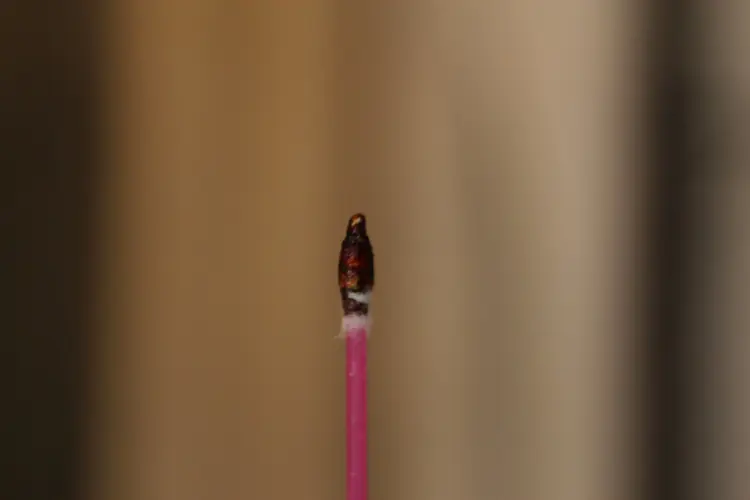
Photo 2. You need to use iodine carefully, applying it to the edges of wounds. Source: Flickr (Kenga86)
Hydrogen peroxide
An excellent first aid treatment for wounds because allows you to wash the wound surface and mucous membraneswithout fear of irritation.
In addition, when it comes into contact with biological fluids, hydrogen peroxide foams, thus washing away all contaminants and already dead cells. When purchasing a product at a pharmacy, you should keep in mind that Only a 3% solution is used to treat wounds. The more concentrated (6%) irritates tissues and is intended exclusively for sterilization of medical instruments.
Note! It is contraindicated to use peroxide to disinfect already healing wounds, since it negatively affects the developing scar, destroying young epithelial cells.
Chlorhexidine bigluconate
An aqueous solution of chlorhexidine with a concentration of active substance of 0.5% has bactericidal activity against viruses, pathogenic bacteria and some fungi.
Not only used for primary treatment of the entire wound surface, but also during the healing stage, speeding it up, as well as for the treatment of purulent wounds.
It has no contraindications; it is a component of various topical antimicrobial agents (gels, suppositories).
Miramistin
The most effective antimicrobial agent, used not only for treating wounds.
An aqueous solution containing 0.01% of the active substance, destroys almost all pathogenic bacteria (including highly resistant nosocomial strains), various viruses and mushrooms.
The drug is completely non-toxic, so it is not contraindicated even for pregnant women and children. When used it does not cause any discomfort. Effective in the treatment of purulent wounds, promotes tissue regeneration.
Potassium permangantsovka
Until recently, potassium permanganate powder was freely sold in pharmacies, and the solution had to be prepared independently by adding a few crystals to water.
Now a ready-made product is sold, which is used for washing and treating wounds.
It is important! Requires special caution in use, as it is not compatible with certain medications. For example, in combination with peroxide it causes severe chemical burns.
The bactericidal effect is present only before the solution evaporates, therefore after drying, it is recommended to additionally use other antiseptics to protect against infection.
Povidone-iodine
The active substance is active iodine bound with polyvinylpyrrolidone, which provides more mild antiseptic effect.
In a regular solution, iodine is very active and has many contraindications, but PVP makes it safe. It does not contain alcohol and is available in the form of a 10% aqueous or 7.5% foaming solution, as well as suppositories and ointments.
Shown for complete treatment of aseptic and purulent wounds, and extensive ones - only at the edges. The limitation is associated with the ability to penetrate through the wound surface into the bloodstream and have a systemic effect. Contraindicated for thyroid diseases.
Fukortsin
The alcohol solution contains active compounds such as
- phenol, which has a bactericidal effect;
- boric acid is a weak antiseptic;
- resorcinol – antifungal and antimicrobial agent;
- fuchsin is a dye with an antistaphylococcal effect;
- acetone - as a solvent.
The wound is treated with fucorcin several times a day using a cotton swab, and the irritating effect of the antiseptic appears briefly - a burning sensation is felt.
Active against fungi and bacteria.
Note! The drug is contraindicated for pregnant and lactating women due to the content of phenol and resorcinol, which have class 2 toxicity.



